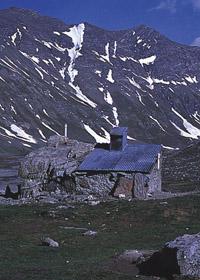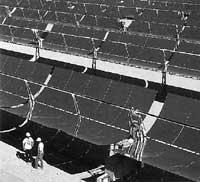Nicoletta del Bufalo "There is much wisdom in ancient architecture"
2000/01/20 Roa Zubia, Guillermo - Elhuyar Zientzia
"There is great wisdom in ancient architecture"
Nicoletta del Bufalo works as a project evaluator at the headquarters of the English company ECOTEC in Madrid. For fifteen years it has been related to the area of savings in buildings and now works for the European Commission dealing with these issues.
What is your concrete obligation?
From any European state we receive projects related to energy and construction and I am one of the evaluators of those projects. These assessments are mandatory since the signing of the Kyoto Protocol. For example, an agreement was signed not to issue more than a few carbon dioxide concentration limits. Very lower levels are required than those currently issued. Therefore, some European projects have had to be paralyzed for not meeting the requirements.
His specialty is energy efficiency. What is it based on?
The basis should be the way to work both in the construction and in the use of new technologies. The characteristics of the energy "healthy" building are the use of design criteria that exploits the advantages of solar energy, the use of orientation and thermal mass (thickness of the walls), the proper arrangement of the windows. Important steps have been taken over the last ten years in the area of professional staff awareness.
And the location of the houses?
It is not yet a topic we include in these projects, but it is of great interest. This problem is evident in poor territories, but at the moment only economic arguments (or almost exclusively) are used to decide their location.
How is the research done?
Research and experimentation has been carried out in other buildings and some technologies have been analyzed and developed by other ways. Therefore, research has no place in these projects. In the market there is a wide range of technology, so it is advisable to use the existing one.
You are driving the use of renewable energy, but are there buildings that today become autonomous with these systems?
There are those that have been used to experiment. In southern Italy and Spain there are examples of this, for example in Andalusia. Mountain huts are a very beautiful example in countries like Germany. Although solar panels are expensive, the connection of the power grid is much more expensive than the use of photovoltaic energies. In some cases it is necessary to use biomass, mainly wood. Thus, shelters can become energetically autonomous. We must take great care of the improvement of conventional technologies in urban buildings, such as structure, orientation, etc.
Solar panels have also multiplied in the shepherds' shacks, but the remains of gasoline are also seen.
No wonder. Solar energy has produced a very curious effect. In the last two decades it has suffered a remarkable decline. Although technology is not complex, especially in southern Europe, it has sold a lot without providing maintenance services. It was really useful in the short term. People remained unremedied. On the contrary, the new generations of these systems have a longer life and, in addition, companies offer a care and a post-sale solution. That's what the user needs. It is related to solar panel technology. They are cheaper and more reliable.
Does energy efficiency never mean a decrease in quality?
Theoretically not, but only theoretically. In that direction there is a lot of work. It is the key word “integration”. This is the set of techniques to improve. The technology of recent years, for example, cannot be used in long-term conventional housing. Experiments have been carried out, for example, in buildings without a fixed user. These buildings are "healthy", that is, they save a lot of energy, they meet ideal conditions to allocate resources, etc. The users of these buildings are satisfied.
Traditional wisdom is also reflected in ancient constructions. Is that not lost?
There is great wisdom in ancient architecture and it has been lost. For example, street and house refreshment systems in hot villages have been collected from Arabs. Only one adaptation was made. For example, the holes to drive the air come from then. They were also used by the Romans, but it is a technology of 2,500 years ago. The current work is to reread and learn to use all that knowledge. Unfortunately, much has been lost. Another is the wisdom of cold peoples.
Which are the municipalities that invest the most money?
We must recognize that they are the peoples of the north. Especially Denmark. For example, the District Heating System is around 1920. There are many differences.

Gai honi buruzko eduki gehiago
Elhuyarrek garatutako teknologia






